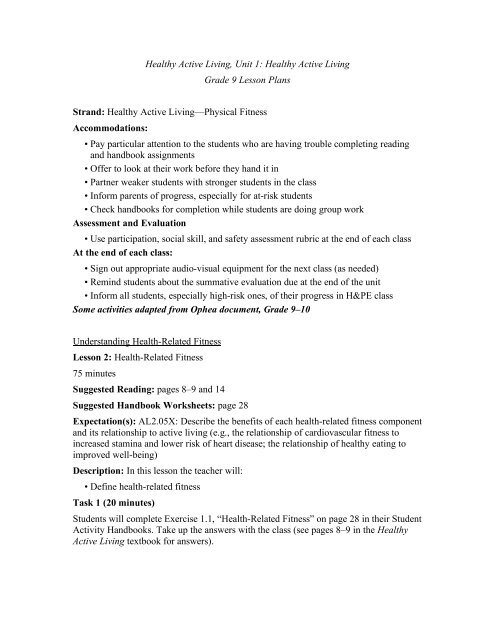Healthy Active Living, Unit 1
Healthy Active Living, Unit 1
Healthy Active Living, Unit 1
Create successful ePaper yourself
Turn your PDF publications into a flip-book with our unique Google optimized e-Paper software.
<strong>Healthy</strong> <strong>Active</strong> <strong>Living</strong>, <strong>Unit</strong> 1: <strong>Healthy</strong> <strong>Active</strong> <strong>Living</strong><br />
Grade 9 Lesson Plans<br />
Strand: <strong>Healthy</strong> <strong>Active</strong> <strong>Living</strong>—Physical Fitness<br />
Accommodations:<br />
• Pay particular attention to the students who are having trouble completing reading<br />
and handbook assignments<br />
• Offer to look at their work before they hand it in<br />
• Partner weaker students with stronger students in the class<br />
• Inform parents of progress, especially for at-risk students<br />
• Check handbooks for completion while students are doing group work<br />
Assessment and Evaluation<br />
• Use participation, social skill, and safety assessment rubric at the end of each class<br />
At the end of each class:<br />
• Sign out appropriate audio-visual equipment for the next class (as needed)<br />
• Remind students about the summative evaluation due at the end of the unit<br />
• Inform all students, especially high-risk ones, of their progress in H&PE class<br />
Some activities adapted from Ophea document, Grade 9–10<br />
Understanding Health-Related Fitness<br />
Lesson 2: Health-Related Fitness<br />
75 minutes<br />
Suggested Reading: pages 8–9 and 14<br />
Suggested Handbook Worksheets: page 28<br />
Expectation(s): AL2.05X: Describe the benefits of each health-related fitness component<br />
and its relationship to active living (e.g., the relationship of cardiovascular fitness to<br />
increased stamina and lower risk of heart disease; the relationship of healthy eating to<br />
improved well-being)<br />
Description: In this lesson the teacher will:<br />
• Define health-related fitness<br />
Task 1 (20 minutes)<br />
Students will complete Exercise 1.1, “Health-Related Fitness” on page 28 in their Student<br />
Activity Handbooks. Take up the answers with the class (see pages 8–9 in the <strong>Healthy</strong><br />
<strong>Active</strong> <strong>Living</strong> textbook for answers).
Task 2 (10 minutes)<br />
Introduce students to the concept of Skill-Related Fitness as outlined on pages 10–11 of<br />
their <strong>Healthy</strong> <strong>Active</strong> <strong>Living</strong> textbook. Emphasize the difference between the two fitness<br />
components and answer any questions that may arise. Ask the class to brainstorm<br />
examples of skill-related fitness.<br />
Task 3 (45 minutes)<br />
Divide the class into four groups. Assign each group one of the following components of<br />
health-related fitness: Cardiorespiratory Exercise, Muscular Endurance, Muscular<br />
Strength, and Flexibility. Each group will brainstorm two examples of exercise for their<br />
component, a definition, the benefits, and an activity or sport that develops this<br />
component.<br />
Bring the class back together and have a spokesperson from each group read their<br />
findings to the class. Keep track of what each group reports by drawing the following<br />
chart on the board or on an overhead:<br />
Component Exercise Definitions Benefits Activity/Sport<br />
Cardiorespiratory<br />
Exercise<br />
Muscular<br />
Endurance<br />
Muscular<br />
Strength<br />
1.<br />
2.<br />
1.<br />
2.<br />
1.<br />
2.<br />
Flexibility 1.<br />
2.<br />
Discuss each group’s findings with the class and answer any questions that may arise.<br />
Remind students that they should copy out the chart in its entirety for use as a study aid.
















